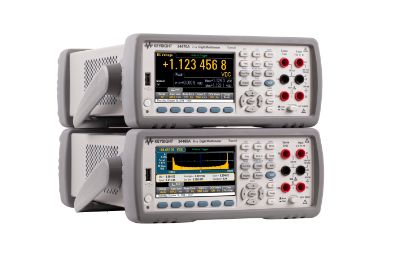
How to Make Accurate Measurements with DMM’s Autocalibration Function
Digital multimeter (DMM) offers an autocalibration function, but it is not found in all DMMs. Autocalibration refers to the ability of a device or system to automatically calibrate itself.
Most DMMs are calibrated in a temperature-controlled environment, nominally at 23 °C. However, often DMMs are used in real-life environments where the temperature is not the same as in the calibration lab. Therefore, an important variable in most DMMs’ specification table, the temperature coefficient (TC) specification adder, determines the guaranteed accuracy specification from manufacturers.
Understanding and using the autocalibration function helps minimize the TC specification adder and will result in less error.
How does the autocalibration function work?
The purpose of the autocalibration function in a DMM is to reduce temperature drift error and internal drift error due to time. For example, in a DMM with autocalibration function, the built-in temperature reference tracks the temperature at which the DMM was calibrated. It knows what the current temperature is, the calibration, and the temperature change. Figure 1 offers an example of a DMM’s autocalibration and a detailed information screen.

Figure 1. Autocalibration screen from Keysight’s 34465A and 34470A DMM.
Autocalibration can be used on an ad hoc basis via a button on the front panel or through SCPI programming commands. When you use SCPI programming commands, you can perform autocalibration at regular intervals to suit your test environment. To minimize errors due to temperature drifts, it is a good idea to perform autocalibration at least every 24 hours. If possible, it is ideal to perform autocalibration just before your production test shift begins.
Figure 2 below shows an example of a DC voltage specification table with and without autocalibration (ACAL) from Keysight’s 34465A DMM. Accuracy specification is in ± (% of reading + % of range). Here are explanations of each column in this table:
Column A – Shows the multiple DC voltage ranges of the DMM.
Column B – Shows DC voltage accuracy specifications with timeframes relative to calibration standards.
Column C – Shows added errors for each °C outside the last ACAL ±2°C. Use this column if you do not use autocalibration.
Column D – Shows added errors for each °C outside ACAL ±2°C. Use this column if you use autocalibration.

Figure 2. Example DC voltage specification table from Keysight’s 34465A DMM.
If you want to measure 9 V on a 10 V range with your DMM, here are the two scenarios with reference to your DC voltage accuracy as shown in the specification table in Figure 2.
Scenario 1: If you do not use ACAL with your DMM
Your guaranteed accuracy will be based on the 10 V range and 1-year specification, a common choice. The errors are calculated as highlighted in the blue circle from column B, plus errors for each °C outside the last ACAL ±2°C, as highlighted in orange circle.
Scenario 2: If you use ACAL with your DMM
Your guaranteed accuracy will be based on the 10 V range and 1-year specification. The errors are calculated as highlighted in the blue circle from column B, plus errors for each °C outside ACAL ±2°C, as highlighted in green circle.
Figure 3 below shows two DMM models, Keysight’s 34465A and 34470A, and their levels of accuracy with and without ACAL turned on, while measuring 9 V on a 10 V range with calibration temperature at 22 ˚C and operating temperature at 40 ˚C.

Figure 3. Comparisons of DMM accuracies with and without autocalibration.
The temperature coefficient is an often overlooked specification adder. At 40 ˚C, the error increased by 106% when compared to the base specification at room temperature. However, if you use ACAL, the error increased by 37% when compared to base specification at room temperature.
Accuracy is often considered a critical specification of products. You often can command a better price for your products if you offer higher accuracy than your competitors. The ACAL feature enables you to characterize your products with better accuracy.
When do I need to use the autocalibration function?
1. Making DMM rack measurements when the internal system temperature is higher than ambient
Say you have mounted your DMM into a rack. The internal temperature of your system is 15 °C, higher than ambient due to the other instruments in your system. With a 15 °C rise, your DMM reading specifications are now higher than design tolerances with the TC specification adders. ACAL can reduce your TC errors and help you meet the specification budget for your DMM measurements.

Figure 4. Test rack with equipment
2. Making highly sensitive, accurate measurements in a lab
If you perform sensor characterization, you may need to make highly sensitive measurements with your DMM while increasing measurement accuracy. However, the temperature of your lab can vary by a few degrees throughout the day. This temperature variation has a direct impact on the accuracy of your measurements and can affect the quality of your data. You can perform autocalibration as frequently as you need to, perhaps preceding every set of characterization tests.
Summary
This post has detailed how autocalibration works in a DMM and its main purpose, which is to reduce temperature drift error and internal drift errors due to time. Based on a DMM specification table (Keysight’s 34465A), you will notice the added errors contributed by temperature coefficient for each °C outside the last ACAL ±2°C. Such errors can add up and make your DMM measurements fall out of your total specification budget.
It is extremely important to consider ACAL when purchasing a DMM, especially when using it to design highly accurate products.
To learn more about Keysight’s True volt series DMMs with a built-in autocalibration function, please go to www.keysight.com/find/truevolt.
Learn more about DMMs by reading 10 Things You Must Know Before Buying Your Next Benchtop Digital Multimeter.

Figure 5. Keysight’s True volt DMM